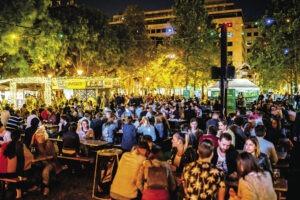Applied arts
The concepts of small-scale and craft breweries are often confused: the difference is best understood by treating the former as a quantitative category and the latter as a qualitative one: craft beers are almost always small-scale, while small-scale beers are very often not craft.
This article is available for reading in Trade magazin 2024/10

Ali Rawech Szami
master brewer
HopTop Brewery
“Hungary’s craft beer market underwent a significant restructuring in recent years. The increase in overheads and raw material prices is putting the sector under severe pressure, while the rise in product prices hasn’t kept up with these costs. Together with a decline in purchasing power, this has led to a setback in the catering sector, so the craft beer market is stagnating”,
says Ali Rawech Szami, master brewer at HopTop Brewery Zrt.
HopTop’s products are typically sold by craft beer specialty stores, craft pubs and large retail chains.
.

Craft breweries play an important role in educating consumers and engaging new consumers (Downtown Beer Festival 2024, photo: spar.hu)
Availability is key

Botond Prischetzky
brand manager
MONYO Brewing
Botond Prischetzky, brand manager of MONYO Brewing:
“Domestic craft breweries are still in a difficult situation, but this trend is perhaps common around the world. A lot of small breweries opened between 2010 and 2020, dozens of which are struggling to survive after the crises of recent years, and many have already closed. The domestic beer revolution has lost momentum a little, but fortunately the market has been able to grow”.
MONYO is present in the big retail chains and products are also available at many HoReCa partners. They are developing their export markets, and have their own webshop and own restaurant, MONYO Tap House, on Kálvin Square in Budapest. It is essential to make craft beers as widely and easily available as possible.

Béla Bukovinszky
managing director
Szent András Brewery
“Small-scale breweries are always more innovative than large ones due to their size, because small breweries are more flexible and can better fill a market niche”,
says Béla Bukovinszky, managing director of Szent András Brewery.
Sales of beers made in small-scale breweries account for around 3-5% of the total beer market, while in some countries with a more developed beer culture their proportion can be as high as 15-20%. Product development at Szent András is both trend-following and trend-setting.
We can brew good beer now

Márton Sefcsik
business development manager
Mad Scientist
“With a little delay, but the trend is coming: the growth of the small-scale market in Hungary isn’t only slowing down but is also stagnating. Of course it is too early to bury beer and this trend doesn’t affect all market players the same way. Still, it is great to be in the craft beer business in Budapest in 2024: quite a lot of people know how to brew good beer today”,
says Márton Sefcsik, business development manager of Mad Scientist.
The brewery’s B2C webshop is very strong, they have a closed Facebook group for consumers and a loyalty programme, but every retail and wholesale partner is different, so they try to move in harmony with key partners, to make sure everyone finds what they are looking for.

A wide choice of beers is a feature of craft beer bars around the world

Gergely Marton
plant manager
The Beertailor
Gergely Marton, plant manager of The Beertailor:
“The composition of the market keeps changing and it is sensitive to the price of raw materials and energy sources, which is why in recent years several breweries, especially smaller ones, have been forced to close, because they couldn’t recover their rising costs”.
In 2019 Panna Cocktail Kft. started producing The Beertailor and Beerka craft beers in its own brewery. For craft beers most of the raw materials are sourced from abroad, so production costs are twice as big as for large-scale breweries.

For the curious and the gourmet

Miklós Orvos
owner
Czech-Hungarian Trading
“In our product selection the share of craft beers is dynamically increasing. Besides classic lagers, Czech new wave beers have also entered the top flight in Europe (and the world), and their availability and good price-value ratio have made them the most sought-after imported craft beers in Hungary”,
informs Miklós Orvos, owner of Czech-Hungarian Trading Kft., an importer of products (both wholesaler and retailer) from small and medium-sized traditional and craft breweries in the Czech Republic.
One of the best ways to promote craft beers is to organise your own events, says Ali Rawech Szami, where you can build a direct relationship with consumers. HopTop has an event called Hoptoberfest: a three-day craft beer festival at the brewery, with programmes, concerts, workshops and factory visits. HopTop’s product development in the premium category of beers has moved towards barrel-aged beers, which represent a higher quality in both ingredients and processes.
To each their own
In the current market situation maintaining volume, market share and the popularity of small-scale beers can be a result, argues Béla Bukovinszky. They participate in a lot of festivals, but these events are more useful in brand building – sales volumes here are marginal. Direct cooperation with large breweries is ruled out by the relevant law, but as several managers of multinational breweries have already stated, they would prefer the acquisition of individual small-scale breweries anyway. Most Szent András cooperations with retail chains are good and the latter are open to working together. Botond Prischetzky sees several possible directions in the development of premium+ beers. The relatively narrow group of consumers who know these beers (NEIPA, sour ale, imperial stout) know that these cost a lot to make and are willing to pay higher prices for them. The other direction is that a growing number of breweries are producing value-for-money champion beers in in-and-out promotions for the big chains, which the big breweries can’t really do.

There are places that “teach” you about craft beer with tasting sessions – here’s a tasting menu from a Japanese pub
Beer experience for everyone
Márton Sefcsik has been working for years to make craft beer lose its snobbish character. Big brewers, small breweries, microbreweries – everyone has forgotten a bit that the genre shouldn’t be about product characteristics or pricing, but about the consumer experience. Craft beer should remain craft beer: it has always been the plaything of the few and not everyone should be forced to like it. There is nothing wrong with being a fan of traditional Czech, German or Belgian beers. Gergely Marton views culinary and cultural events as a good opportunity for promoting and marketing The Beertailor’s craft beers, but in many cases being there is so expensive that these projects end with a loss or minimal profit despite good sales. Their products are available in retail and catering outlets, and they also have their own online shop. Miklós Orvos stresses that one of the most important steps in the promotion of their products is to present the beers in reality and virtually. They participate in various beer and gastronomy festivals, and they also organise so-called tap events, where the representatives of guest breweries are pouring and tell participants all about their beers and their brewery. //
Status report

Péter Starcsevics
president
Association of Craft Breweries (KSE)
According to Péter Starcsevics, president of the Association of Craft Breweries (KSE), the brewing industry is facing difficult times at the moment.
“Raw material, energy and labour costs have increased dramatically in recent years. People are also spending noticeably less. The general drop in consumption this year is also reflected in beer sales. Small breweries aren’t willing to compromise on quality and are trying to be more efficient in production and logistics”,
he says.
Various events are an important sales opportunity for breweries. At festivals and gastro-events they can meet consumers directly, promote their products and receive immediate feedback. Both small breweries and large ones agree that quality beer has an important place in gastronomy. Retail chains are opening up to craft beers, but in the president’s opinion they often prefer to have craft beers brewed especially for them, because they are cheaper than local small-scale beers. //
The Czech model

György Vétek
beer columnist
Hungary’s beer revolution got where it is now with a second impetus in the late 2010s, opines beer writer and the author of dozens of Czech-themed beer guides, György Vétek.
“Since then neither the number of breweries has increased, nor their share in domestic beer production has really grown. If we want to move forward from here, we would need several things”,
he says.
What are these? More breweries, including five or six large ones with a capacity of 60,000-80,000 hectolitres/year, serving a region (three or four counties) with good quality beers. Most domestic small-scale breweries typically just want to sell beer, instead of also offering a service – being present in people’s lives. Czech breweries are a good example of the latter: there over 90% percent of the 570 or so breweries are located in rural areas, often in small villages with barely a thousand inhabitants. At least 80% of them have on-site eating and drinking facilities and a third provide accommodation service too. In many small villages the pub is the scene of community life in the village, with fire pits in the garden, weddings, films, plays – and of course beer!

Hostivar in Prague is a typical service brewery with a restaurant, a bakery and take-away
//
Related news
Belgian beer exports decline again in 2024
Total export volumes dropped 3.4% in 2024 to 14.5m hectolitres,…
Read more >How do you have your coffee, shaken or stirred?
This article is available for reading in Trade magazin 2025/5.…
Read more >Related news
Fiatalok az agrár-élelmezési szektorban a FAO kutatása szerint
The Food and Agriculture Organization of the United Nations (FAO)…
Read more >More and more people are choosing Lake Balaton instead of Croatia this year – but caterers can’t sit back
Although the 2025 summer season at Lake Balaton promises strong…
Read more >Hotels for sustainability
According to estimates, hotels are responsible for 10% of food…
Read more >






